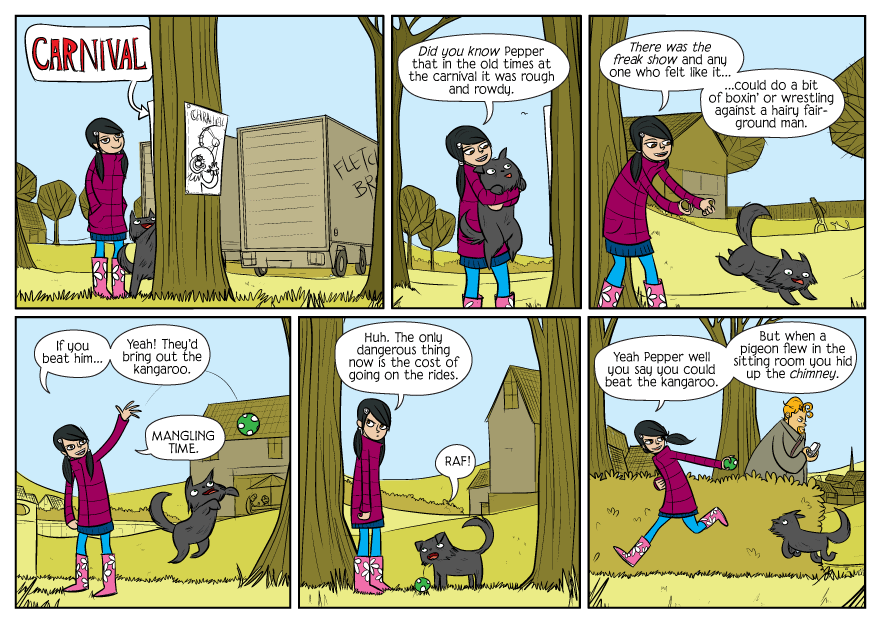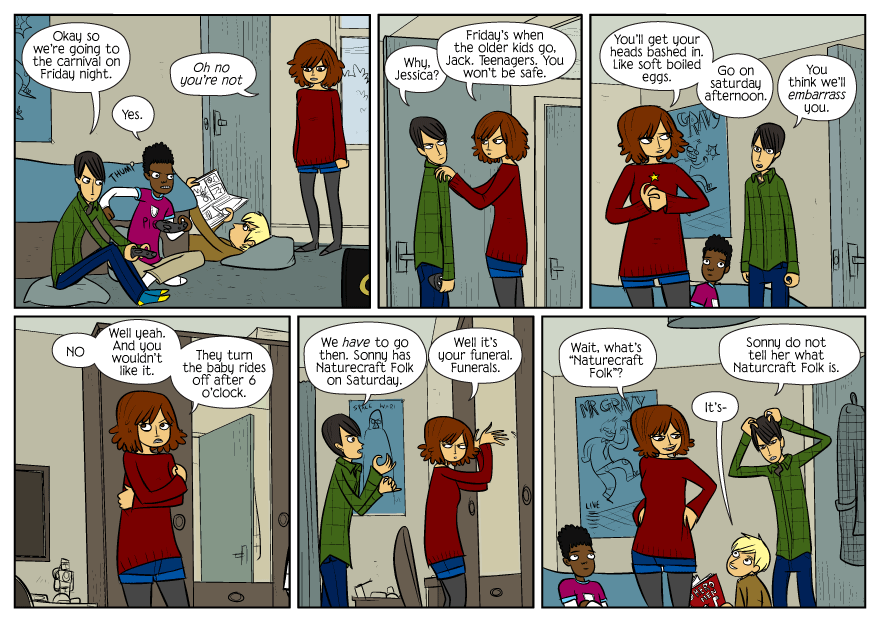Cartoonist John Allison surprised many in 2009 when he ended his long-running webcomic Scary Go Round and soon launched Bad Machinery, which follows the adventures of two groups of child detectives in the fictional town of Tackleford, England, he established more than a decade earlier in his first online strip Bobbins.
Allison is the first to acknowledge those first months were rocky for the kids of Griswalds Grammar School, with a number of Scary Go Round readers abandoning the new comic, despite its familiar setting. But four years later, it's a different story for Bad Machinery, which in 2012 won a British Comic Award; the first print collection, released last spring by Oni Press, was named by Publishers Weekly as one of the best children's books of 2013.
With a second volume, "The Case of the Good Boy," set to arrive in March, Allison took some time during the holidays to talk with ROBOT 6 about finding an audience, making the jump to print, returning to Bobbins and what the future holds for Bad Machinery.
Kevin Melrose: You’ve had a good couple of years, with Bad Machinery winning a British Comic Award, followed by the release of the first Oni Press collected edition, named by Publishers Weekly as one of the best children’s books of 2013. That’s a long way from 2009, when Bad Machinery seemed like a shaky proposition following your decision to end Scary Go Round. Can you talk a bit about the struggles of that first year, as far as readership and self-doubt?
John Allison: I'd been plowing the same furrow for years before I started Bad Machinery, and when the time for change came, I assumed that things would progress the same way. Astonishingly, this didn't happen and for a few months I was a bit miserable about it. I wish I'd never said anything - one should never show weakness. If you don't believe in what you're doing, why should anyone else? I've talked a few times since about giving people "jumping-off points" and there, I created a huge one. I lost a lot of casual readers who'd probably had enough, and a few for whom the new cast we so different from the old that they felt slighted and abandoned. I've since heard from many members of both groups who got curious, came back, and found things had improved a lot. It took me time to settle into the new way too.
You launched Bobbins way back in 1998, which makes you one of the elders of webcomics at the ripe old age of, what, 37? What spurred you to take your comic online at a time when there weren’t that many people doing it? What was the webcomics landscape like at the time?
I think the difference was, I worked on my university's online magazine and knew how to make a website. I'd been on comics newsgroups and knew other people were doing this. But I had no anticipation of an audience -- it was really just a place to show my comics to my friends. Every week I'd put up five pages, and post to rec.art.comics.strips to no great effect. After a month or so of doing this I found Goats and Helen, Sweetheart of the Internet -- both of whose creators were very kind and generous to me.
While the collection of “The Case of the Team Spirit” has certainly earned greater critical attention for Bad Machinery, have you noticed any change in readership – either in numbers or in demographics – as a result of the print edition?
It's really hard to tell at this point, as the book is widely available in bookstores and libraries in the U.S. and Canada but not in my native U.K. -- it's kind of comic shops, Amazon, and that's it here. So I haven't got to meet as much of my audience as I might like to. In the last few years I've started to suffer from labyrinthitis after flying, which makes traveling to North America really hard -- I miss that a lot. I miss the people, and the huge dinners. I basically spend a couple of days with the world yawing and pitching around me after a long haul flight. But I've seen the way kids connect to the print edition, with its large format, and it's hugely gratifying. Librarians are really behind the book, too, which is wonderful.
What can readers who might not be well-versed in Bad Machinery expect from “The Case of the Good Boy” when it arrives in March?
"The Case of the Good Boy" concerns disappearing infants, budding young love, hairy beasts, tough times and a classic magic pencil scenario. There's a lot going on. The Bad Machinery books are mystery tales where the mystery is less important than the ins and outs of friendship between the kids solving the mysteries.
That story was originally serialized online in 2010. When you look back to 2009, 2010, do you see a lot of progression in your own work, and in your characters?
The first two stories were definitely learning experiences -- finding out about the characters, working out how to tell stories that were longer than I had done before. When I prepared this one for the book edition, I added 30 or so new pages using what I'd learned since. It's fun because I can sneak in characters who don't appear until later, and beef up parts of the story in ways that might not have worked in a daily webcomic, where every page has to be a definite beat. I've moved on a lot as an artist, but there are both losses and gains as time goes on, and revisiting older work sometimes makes me think, why did I stop doing that, there's room for more of it. The characters are aging fast -- 11 and 14 (which they are now) are such different ages. It creates problems in a series like this too - you're going to be running into areas that maybe aren't appropriate for younger readers. There's a minefield on the horizon.
You’ve taken breaks from Bad Machinery for shorter stories like Giant Days and, currently, new Bobbins. What importance do those play to your creativity/state of mind? When did you realize you need to step away from longer-form storytelling from time to time?
Working on the same story for six months is exhausting. You're working on a story that someone could sit down and read in an hour and a half or so, for half a year. The shorter stories like Giant Days give me a chance to work at a different pace, and Bobbins even more so. Sometimes friends ask me to work on anthology pieces, and I'd found that I couldn't do just one standalone page any more - I'm used to having a huge amount of space to develop a theme. So I started making Bobbins strips again, where I was penned into the old-fashioned newspaper strip and had to get in and out fast. After a few weeks of that I was able to do things like the one-shot I did for Cards Against Humanity and Cupcakes McKenzie, which was tremendously popular.
The only downside now is that I keep having ideas that aren't Bad Machinery, that I will never have time to develop alone. I came up with a series called Robert Cop that emerged fully formed one afternoon. It could be brilliant, but we may never know. And then I had an even better idea called Life Goes On that felt like I could have drawn it for a long time and made it something special. Most importantly, neither had anything to do with my previous work, the Bobbins-verse or whatever. It didn't feel like a webcomic, either. Part of what makes a series work for me is just that there's a lot of it, a believable world, and drawing it myself is what a. makes it real for me and b. makes it impossible to do much more than I do right now.
Bobbins ran for about four years, and Scary Go Round for about seven. How long do you envision Bad Machinery continuing?
As I said before, there's a point where Bad Machinery isn't the comic it was when I started, when the kids get to 15 or 16. The innocence will be gone and at that point I have to decide what to do. There's a case for every term of senior school, which means 21 cases, and the next one will be the eighth. But the last 6-8 cases would, essentially, be about young adults. You can still be a real kid at 16, or you can be a total proto-adult. Same as always, I'll feel it out as I go. As long as I'm still drawing breath, we can always go back.
Bad Machinery, Vol. 2: The Case of the Good Boy is due March 12 from Oni Press.



